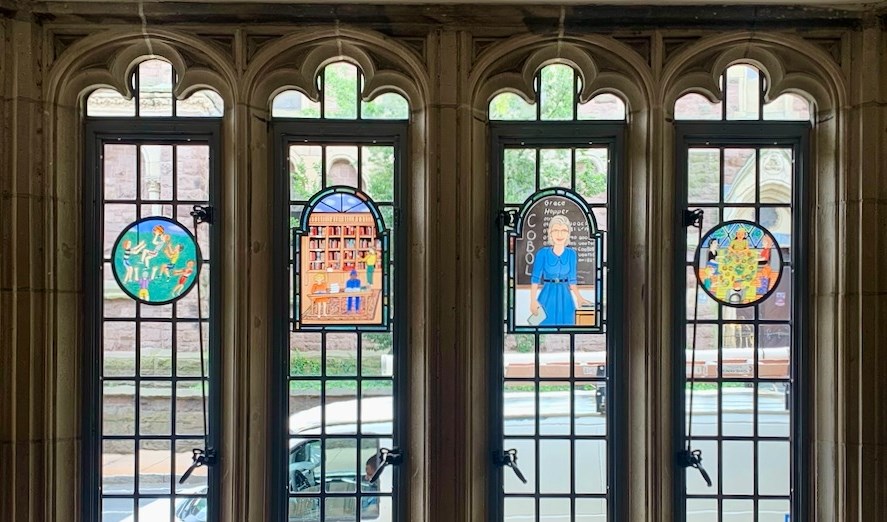Yale replaces slavery-influenced windows with student life tributes
The removed windows are now stored in the university's archives to serve as reminders of a history still roaming in the corners of the present.
-

The series of stained-glass windows at Yale (Yale Alumni Magazine)
In 2017, one of Yale University’s residential colleges dropped the name it carried for 84 years - the name of former US President John C. Calhoun, a Yale graduate who was an intense supporter of slavery - and denounced him as a white supremacist. It elected another Yale alumnus instead: the pioneering computer scientist and mathematician Grace Murray Hopper.
The name change took place in 2016 when an African-American dining-hall worker, Corey Menafee, smashed a stained-glass window that illustrated enslaved people picking cotton. Fast forward, and as a result of lengthy discussions concerning the college’s past, present, and future, a dozen windows in the building have been permanently replaced with ones designed by artists Faith Ringgold and Barbara Earl Thomas.
-

One of the artists, Barbara Earl Thomas (UW Magazine)
The new designs commemorate various students and staff, while simultaneously acknowledging the university's ties to racist practices. Thomas’ six designs are installed in the college’s dining hall and Ringgold’s other six are in its common room to replace an entire set that portrayed a visual timeline of Calhoun’s life.
Artist Anoka Faruqee, associate dean at the Yale School of Art and chair of the committee formed in 2017 in charge of the window commissions, stated on the matter, “We had two missions... to confront, not erase, the history of slavery in the United States, and Yale and Calhoun’s connection to it, and to celebrate and honor the legacy of a brilliant thinker and mathematician, Grace Hopper.”
The committee, consisting of faculty, staff, and students, selected Ringgold and Thomas by taking into consideration their relationships to storytelling and the content of their work, as well as the ways in which they have addressed the US history of racism.
According to Faruqee, “Faith Ringgold was basically the first artist we reached out to,” adding, “Faith’s long career working in a variety of media, including quiltmaking and children’s books, was something that drew our attention, and her commitment to storytelling and forms of art-making that exist outside of a kind of rarefied art world.”
Ringgold’s windows portray student life, including pottery and basketball activities. One window pays tribute to Hopper in front of a chalkboard inscribed with the letters COBOL which refer to the standardized programming language she co-developed.
“The removal of the vestiges of John C. Calhoun’s life has felt like some kind of lifting, some sense of change, acknowledgment on the part of the university of its history and its complicity with slavery,” Faruqee expressed. “The art is one necessary piece of this, for me personally, of imagining and envisioning a different future. But it’s not the only piece of a journey toward justice.”
In a glass medallion named "The Winds of Change" by Thomas, a robin flies away with a banner with Calhoun’s name, and a hummingbird brings another banner with Hopper’s name instead. “Calhoun’s name is in its correct place in history, in the background,” Thomas says. “What I wanted to do, number one, was tell the story of the name change in a way that honoured all of the people who struggled and made their voices heard—the students, faculty and staff who really were in these very energetic conversations . . . I was not there raising my voice, but I understood the movement, and I understood the earnestness the students were bringing to their effort.”
"From Kitchen to Table" is another artwork by Thomas that praises kitchen staff, showing four workers standing in the dining hall. This was the result of a discussion with Yale students who requested more centrality and contribution of campus workers to student life.
As part of her Yale commission, Thomas suggested an idea: in November, two portraits of Hopper and Roosevelt L. Thompson, a beloved Yale student who died in a car accident in his senior year and after whom the dining hall is named, will be installed. Each of the portraits will be backlit to cast shadows around the room at night. “That was my added opportunity to say something about this historic moment, the changes that happened at Yale in these last two or three decades,” the artist said.
The windows that were removed are now stored in the university's archives to serve as reminders of a history still roaming in the corners of the present.

 4 Min Read
4 Min Read








